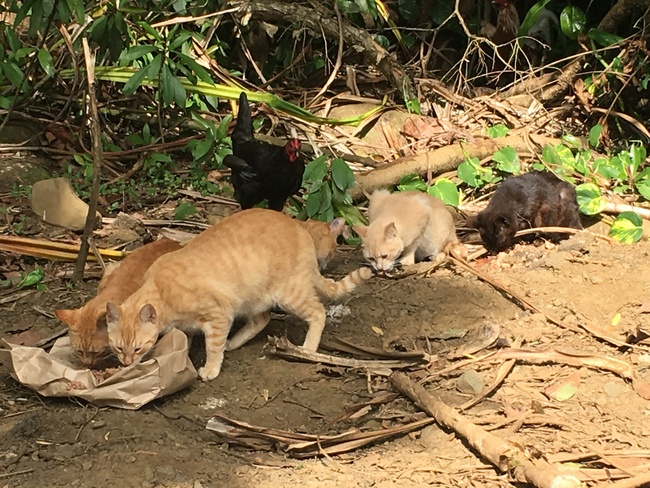Kitty Konundrum: The Environmental Impact of Feral Cat Reproduction

1. Lesson Abstract
This lesson will ask students to meet standards in Math and ELA by practicing mathematical estimates of cat reproduction in combination with close reading of research on the effects of feral cats on the environment. In this way students can experience the interdisciplinary nature of math, science, and language arts in a way that is applicable to the environment of Hawaii. The mathematical portion of this lesson may take one to two periods, with subsequent research, close reading and writing taking 2 or more periods.
2. Lesson Themes
Feral cat reproduction in the wild, and the environmental impact on the native species of Hawaii
3. Essential Questions
What is an accurate estimate of how cats reproduce in the wild?
What are the environmental impacts of feral cats?
What solutions can we find to lessen the negative impacts of feral cats on the environment of Hawaii?
4. Standards Addressed
Choose Your STEM Inquiry Standard
Practice/process standards from the NH science standards that address scientific inquiry
- S:SPS1:11:1.1 Ask questions about relationships among variables that can be observed directly as well as those that cannot.
- S:SPS1:11:1.2 Use complex classification criteria and keys to
identify items/organisms.
Content standards from the NH science standards
- S:ESS1:11:1.1 Explain how winds and ocean currents are
created on the Earth’s surface.
- S:ESS1:11:1.2 Explain how heat and energy transfer in and
out of the atmosphere; and provide examples of how it is
related to weather and climate.
Related Resources
New Hampshire K-12 Science Literacy Framework
Next Generation Science Standards
Standards for the 21st Century Learner (AASL)
National Educational Technology Standards (NETS)
Common Core State Standards for Mathematics
Choose Your Common Core Anchor Standards
Below is a list of grade-specific standards that focus on building evidence and constructing arguments through close reading of science and technical texts.
Citing textual evidence
- CCSS.ELA-LITERACY.RST.6-8.1: Cite specific textual evidence to support analysis of science and technical texts
- CCSS.ELA-LITERACY.RST.9-10.1 Cite specific textual evidence to support analysis of science and technical texts, attending to the precise details of explanations or descriptions.
- CCSS.ELA-LITERACY.RST.11-12.1 Cite specific textual evidence to support analysis of science and technical texts, attending to important distinctions the author makes and to any gaps or inconsistencies in the account.
Determining central ideas or conclusions
- CCSS.ELA-LITERACY.RST.6-8.2 Determine the central ideas or conclusions of a text; provide an accurate summary of the text distinct from prior knowledge or opinions.
- CCSS.ELA-LITERACY.RST.9-10.2 Determine the central ideas or conclusions of a text; trace the text's explanation or depiction of a complex process, phenomenon, or concept; provide an accurate summary of the text.
- CCSS.ELA-LITERACY.RST.11-12.2 Determine the central ideas or conclusions of a text; summarize complex concepts, processes, or information presented in a text by paraphrasing them in simpler but still accurate terms.
Related Resources
Common Core State Standards for English Language Arts
5. Learning Objectives
Math Objectives:
- Interpret a situation and represent the constraints and variables mathematically.
- Select appropriate mathematical methods to use.
- Make sensible estimates and assumptions.
- Investigate an exponentially increasing sequence.
- Communicate their reasoning clearly.
ELA Objectives:
- Read scientific texts closely to interpret author's purpose
- Cite specific evidence in a text to support its main arguments
- Evaluate scientific readings for author's purpose and biases
- Write informative/explanatory texts to examine a topic and convey ideas
- OR Write effective arguments to support claims with clear reasons and relevant evidence
Related Resources
Tips for Writing Student Learning Outcomes - IUPUI
6. Text Set
Title
of Anchor Text:Feral Cats: Too Long a Threat to Hawaiian Wildlife
URL of Anchor Text: http://www.usgs.gov/ecosystems/pierc/assets/cats.pdf
Supporting Texts:
Maui's Feral Cat Population is So Massive It's Threatening a Local Bird Sanctuary
Resolving the Feral Cat Conundrum
7. Student Tasks and Organization of Instructional Activities
Introduction
There are many staggering but conflicting reports about cat reproduction, and how many kittens one cat can produce in a lifetime. Read the following reports:
The Department of Land and Natural Resources on Maui calculated that if a single unspayed female cat produces 2 litters per year, with 2.8 cats surviving each litter, she and her offspring can create 11.6 million cats over a nine year period.
-James Cave, Huffington Post
At some point, most of us have attempted to feed or comfort a wide-eyed feral cat. One reason is there are so many of them -- female cats can start producing offspring as young as 4 or 5 months of age, and they may give birth to a litter twice a year thereafter. By some estimates, a male and female cat can create a population of over 400,000 cats in seven years! It's therefore easy to see how a colony of feral cats can grow quickly.
-Elizabeth Parker, Published in Hawaii News Now
Step One: Using Mathematical Models for Estimation
To test the accuracy of these estimates, complete the formative assessment: Modeling Population Growth: Having Kittens
Step Two: Scientific Textual Analysis
Read: USGS's article: Feral Cats: Too Long a Threat to Hawaiian Wildlife
Complete: Worksheet #1
Suggested Further Steps, Formative and Summative Assessments
- Read the supporting texts and complete the same worksheet, then compare and evaluate the resources for credibility, biases, etc.
- Summarize the texts accurately in writing
- Compose informative/explanatory writing incorporating the math exercise, the assigned readings, and other research to inform their audience of the impact of feral cats
- Research solutions and compose argumentative writing that makes a claim about the best solution for the "Kitty Konundrum" and gives clear reasons and evidence from research to support claims. Students can be taken through the steps of the research process to create polished, documented, and formatted argumentative research papers.